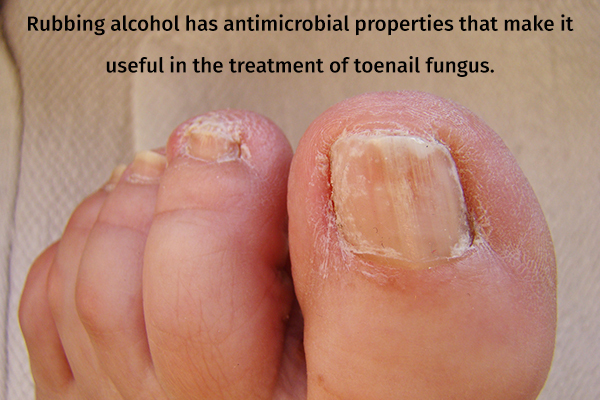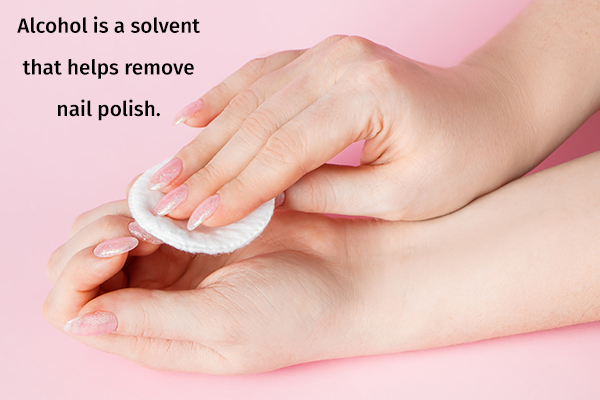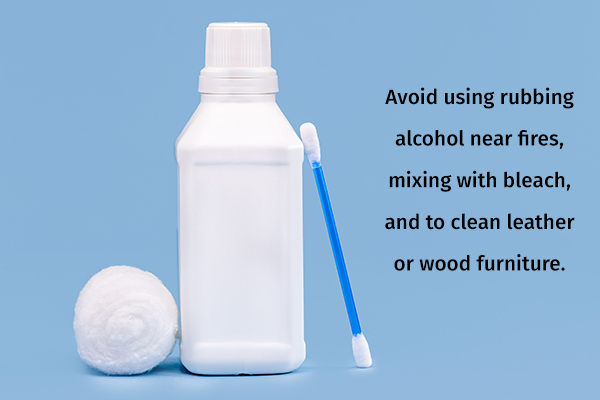In this article:
Rubbing alcohol is a solution made up of 70%–90% isopropyl alcohol mixed with distilled water. It is a powerful germicide, disinfectant, cleaning solvent, and pain reliever that is useful to have in a household.

Here are some amazing uses of rubbing alcohol. (1)
1. Kills Head Lice

Head lice are a common parasite, especially among children. Not only are they an annoyance, but they can be extremely difficult to get rid of. Rubbing alcohol can help kill head lice and their nits quickly.
How to use:
- Mix 1 tsp of rubbing alcohol and 5 drops of tea tree oil.
- Apply this mixture to your hair and spread it with your fingers.
- Wait for 7–10 minutes for it to work.
- Bend over a tub and brush lice and nits out of your hair with a fine lice comb.
- Wash your hair with a mild shampoo.
- Repeat this remedy once every 10 days.
2. Prevents Swimmer’s Ears

Water that gets into your ear canal during swimming can be discomforting and lead to ear infections. Hence, it should be gotten rid of quickly.
Rubbing alcohol is a dehydrating agent and helps clear the water easily. Using 70% isopropyl alcohol to clean your ear once a week prevents water accumulation. (2)
Note: Consult your doctor before using rubbing alcohol in your ears.
How to use:
- Mix a few drops of rubbing alcohol with a few drops of white vinegar.
- Pour this solution into your ear after taking a swim.
- Let the liquid stay in your ear for 5 minutes.
- Tilt your head in the opposite direction to drain the excess liquid.
3. Relieves Muscle Aches

Topical application of rubbing alcohol helps reduce pain and stiffness. It can also stimulate blood flow to the area and alleviate tension. Thus, rubbing alcohol can be used as a remedy for muscle pain and aching joints.
How to use:
- Apply a few drops of rubbing alcohol to the affected area.
- Massage for 5–10 minutes.
- Wrap a warm cloth on the affected area for half an hour.
4. Helps Treat Toenail Fungus

Rubbing alcohol has antimicrobial properties that make it useful in the treatment of toenail fungus.
Toenail fungus also tends to grow in warm, sweaty skin. As alcohol is a drying agent, it helps kill the infection and prevent it from returning.
How to use:
- Wash your feet with soap and water.
- Clean your toenails with a nail brush.
- Dry your feet, and then soak them in a bowl filled with rubbing alcohol and warm water (1:1 ratio) for 15 minutes.
5. Soothes Mosquito Bites

Mosquito bites can cause itching and irritation. Rubbing alcohol has cooling properties that can help soothe the mosquito-bitten skin.
Moreover, rubbing alcohol exhibits antiseptic properties that can reduce the risk of infection.
How to use:
- Apply 2–3 drops of rubbing alcohol directly to the area.
- Massage the skin gently for 2–3 minutes.
- Leave it to dry for at least 5 minutes before washing it off.
- Use a moisturizer to reduce the dryness caused by alcohol.
Note: Avoid using too much rubbing alcohol as it may irritate the skin.
6. Cleanses Minor Cuts and Abrasions

Rubbing alcohol is an antiseptic and can help disinfect minor wounds to avoid infections. It can be used on minor cuts and abrasions to kill bacteria.
How to use:
- Put a few drops of rubbing alcohol on a cotton ball or pad.
- Gently apply it to your small cut.
- Let it rest for a few minutes before removing it.
7. Reduces Body Odor

Rubbing alcohol can be used as a deodorant. Due to its antimicrobial properties, it helps get rid of odor-causing bacteria on the skin.
Alcohol is also a drying agent that helps reduce sweat. (3)
How to use:
- Put a few drops of rubbing alcohol on a cotton pad.
- Gently rub your underarm area with this pad.
Note: Avoid applying rubbing alcohol soon after shaving, as this will cause stinging.
8. Removes Nail Polish

Alcohol is a solvent that helps remove nail polish. In fact, most store-bought nail polish removers are made up of isopropyl alcohol.
How to use:
- Pour a little bit of rubbing alcohol on a cotton ball.
- Rub it on your nail till the polish comes off easily.
9. Treats Poison Ivy Irritation

Rubbing alcohol has anti-inflammatory properties and can be used to soothe irritated and itchy skin. It can provide instant relief if you get exposed to poison ivy or other skin irritants.
How to use:
- Pour some rubbing alcohol on a paper towel.
- Gently wipe the irritated skin with it.
- Wait for a few minutes for the alcohol to dry.
- Wash it off with soap and water.
Note: Rubbing alcohol should be avoided by people with sensitive skin since it might cause dryness and peeling.
10. Used in Hand Sanitizers
Rubbing alcohol is a potent germicide and is used to make hand sanitizers. Most hand sanitizers contain at least 60% isopropyl alcohol. Hence, rubbing hand sanitizer on your hands for at least 30 seconds is enough to clean your hands off most bacteria. (4)
How to use:
- Mix 2 cups of rubbing alcohol and 2 tbsp of aloe vera gel in a bowl.
- Add 2–3 drops tea tree oil and mix again to get rid of the powerful alcohol smell.
- Pour this solution into a container and your homemade hand sanitizer is ready.
Safety Tips

- Avoid using rubbing alcohol near fires. Alcohol is highly flammable. Make sure to keep it away from direct heat.
- Avoid mixing bleach with rubbing alcohol. Mixing rubbing alcohol with other cleansing agents can cause chemical reactions and produce harmful gases.
- Avoid using rubbing alcohol to clean leather or wood furniture: Rubbing alcohol can act as a solvent when it comes in contact with wood or leather. It can easily dissolve the surface varnishing or coating on furniture and should not be used on wooden doors, tabletops, floors, etc.
Final Word
Rubbing alcohol can be a very useful household tool. However, ingesting it can be lethal, so make sure to keep it out of the reach of children or pets. Contact your doctor immediately if you have an allergic reaction (irritation, redness, or inflammation) to rubbing alcohol.
- Was this article helpful?
- YES, THANKS!NOT REALLY


